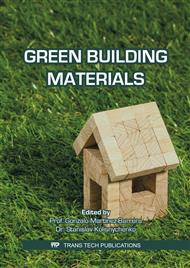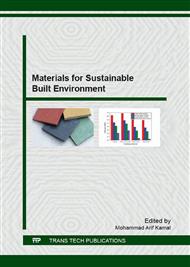p.1
p.9
p.17
p.27
p.38
p.45
p.54
p.66
Engineered Cementitious Composites for Sustainable Construction
Abstract:
Upcoming infrastructure and maintenance focuses on sustainable infrastructure. To solve this, certain cement – based materials are developed. Engineered Cementitious composite (ECC) has been developed as an improved version of Fiber Reinforced Cement. The most outstanding properties of ECC are its high tensile ductility and fine multiple cracking. It is basically a composite similar to mortar added with fine fibers such as steel fibers and polymer fibers. A composite with high ductility is made retaining the original properties of normal concrete leads to a sustainable and serviceable construction. The materials used for ECC are cement, fly ash, fine cement, admixtures, fibers and water. Sand used in this mix is very fine which have 0.1mm dia. The fibers used in this study are polypropylene and steel fiber. Fibers are added at the rate of 0.5%, 1%, 1.5%, 2% volume of cement. This paper deals with the experimental investigation of compressive strength, tensile strength, and flexural strength of ECC made with polypropylene and a mixed proportion of polypropylene with steel fiber with different volume percentages i.e., 2%, 1.5%, 1% and 0.5%. It is observed that addition of fibers increased the ductile behavior. ECC with polypropylene fiber had shown significant improvement in tensile and flexural strength while ECC with hybrid fiber had given appreciable compressive strength development. These efforts will focus on the development of sustainable green material, which reduces the negative impact of existing concrete on the environment. The potential application of ECC to achieve structural sustainability has been observed from the results obtained.
Info:
Periodical:
Pages:
17-26
Citation:
Online since:
May 2016
Authors:
Keywords:
Price:
Сopyright:
© 2016 Trans Tech Publications Ltd. All Rights Reserved
Share:
Citation:



